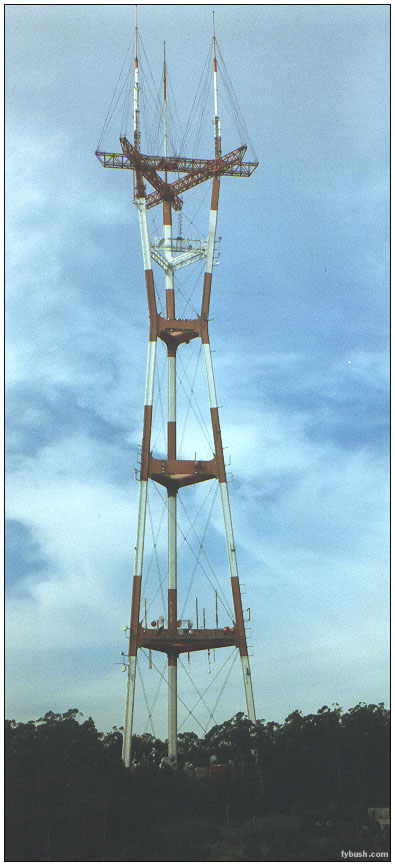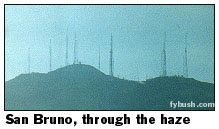June 6-13, 2001
Sutro Tower, San Francisco
 Here
at Tower Site of the Week, we pride ourselves on listening to
our readers' desires. Since this page launched last fall, scarcely
a day goes by without someone clicking on the link at the bottom
of the page and offering a suggestion for a site to feature here. Here
at Tower Site of the Week, we pride ourselves on listening to
our readers' desires. Since this page launched last fall, scarcely
a day goes by without someone clicking on the link at the bottom
of the page and offering a suggestion for a site to feature here.
We're limited, of course, by what's actually in the collection
- thus no Cedar Hill in Dallas, WSB in Atlanta, or the hill above
Anchorage (yet!)
One of the most consistent requests, though, is for a site
we've admired many times: Sutro Tower, rising 977 feet above
the center of San Francisco.
To the radio geek, this is one of the most impressive sites
out there, easily seen from just about any approach to the City
by the Bay.
To the neighbors (many of them, anyway), it's a giant eyesore
rising above their dense urban community. Ever since the tower
began rising from the old hilltop estate of the Sutro family
in 1971, it's been a source of controversy and contention, especially
with the addition of DTV.
Some history, then? Very well: Television in the Bay Area
began at several scattered sites in the late 40s and early 50s.
KRON (Channel 4) used a tower on Mount San Bruno, on the peninsula
south of San Francisco, later joined there by KTVU (Channel 2).
KPIX (Channel 5) began with an antenna atop the Mark Hopkins
Hotel on Nob Hill. And when ABC put KGO-TV (Channel 7) on the
air in 1949, it bought the old Sutro mansion on one of the city's
highest points, building a short tower that was used by KGO-TV,
KGO-FM (103.7, now KKSF) and eventually by KPIX as well.
In 1968, KTVU, KRON, KPIX and KGO jointly founded Sutro Tower,
Inc. to build a new tower on the hill. Construction began three
years later, and by the summer of 1973 the tower was finished
and put in regular broadcast use. (KRON had proposed a 700-foot
tower of similar design to crown San Bruno; it was turned down
by the FAA because of safety concerns for planes heading into
nearby San Francisco International Airport.)
 In
addition to the four tower owners, space on the tower is leased
to many additional tenants. Public broadcaster KQED-TV (Channel
9), along with then-sister KQEC (Channel 32, now KMTP), were
given space at discount rates when they became charter tenants.
On the UHF dial, KBHK (Channel 44) was an early tenant, later
joined by KBWB (Channel 20, previously KOFY-TV and KTZO), KCNS
(Channel 38, previously Dr. Gene Scott's KVOF) and later, KPST
(Channel 66, licensed to Vallejo). In
addition to the four tower owners, space on the tower is leased
to many additional tenants. Public broadcaster KQED-TV (Channel
9), along with then-sister KQEC (Channel 32, now KMTP), were
given space at discount rates when they became charter tenants.
On the UHF dial, KBHK (Channel 44) was an early tenant, later
joined by KBWB (Channel 20, previously KOFY-TV and KTZO), KCNS
(Channel 38, previously Dr. Gene Scott's KVOF) and later, KPST
(Channel 66, licensed to Vallejo).
On the FM dial, many respected Bay Area engineers believe
Sutro is a less-than-optimal site, since signals from this location
are blocked towards the South Bay area much more so than their
counterparts from San Bruno, to the south, or Mount Beacon, in
Marin County north of the Golden Gate.
 Nevertheless,
the TV stations that built the tower dutifully installed their
FM outlets there as well. KGO-FM (103.7, now KKSF) and KRON-FM
(96.5, now KOIT-FM) have been here since the beginning. Also
on board were KCBS-FM (98.9) and KFOG (104.5), with the rest
of the area's broadcasters staying put on San Bruno, Mount Beacon,
and a handful of other single-station sites. CBS later traded
its 98.9 signal for the much more potent 97.3 from Beacon. 98.9
became KMPX (which had moved from 106.9, the frequency traded
to Family Stations for its 97.3 KEAR facility), and later went
through a long succession of calls before landing as Spanish-language
KSOL. KFOG eventually added KFFG (97.7 Los Altos) to extend its
signal in the South Bay. Nevertheless,
the TV stations that built the tower dutifully installed their
FM outlets there as well. KGO-FM (103.7, now KKSF) and KRON-FM
(96.5, now KOIT-FM) have been here since the beginning. Also
on board were KCBS-FM (98.9) and KFOG (104.5), with the rest
of the area's broadcasters staying put on San Bruno, Mount Beacon,
and a handful of other single-station sites. CBS later traded
its 98.9 signal for the much more potent 97.3 from Beacon. 98.9
became KMPX (which had moved from 106.9, the frequency traded
to Family Stations for its 97.3 KEAR facility), and later went
through a long succession of calls before landing as Spanish-language
KSOL. KFOG eventually added KFFG (97.7 Los Altos) to extend its
signal in the South Bay.
 There's one other
site easily seen from up at Sutro. Just a mile or so away, at
the south end of Twin Peaks (a very popular drive for tourists),
this city-owned tower shown at right carries KALW (91.7), the
public radio station operated by the San Francisco school district.
KALW is one of the oldest noncommercial stations in the country,
dating its heritage back to the very early 1940s and the old
42-50 MHz FM band. Its two directional FM bays are mounted on
the top left side of the tower; look very carefully! There's one other
site easily seen from up at Sutro. Just a mile or so away, at
the south end of Twin Peaks (a very popular drive for tourists),
this city-owned tower shown at right carries KALW (91.7), the
public radio station operated by the San Francisco school district.
KALW is one of the oldest noncommercial stations in the country,
dating its heritage back to the very early 1940s and the old
42-50 MHz FM band. Its two directional FM bays are mounted on
the top left side of the tower; look very carefully!
We mentioned controversy before, and we meant it. How many
towers have their own Web sites created by concerned neighbors?
Check out www.sutro.org to
see what the neighbors have to say about the dangers of RF and
earthquake stability (though with 15 million pounds of concrete
in the ground, this tower's center of gravity is actually below
the hilltop!), as well as the latest on their fight to keep the
DTV installation on the tower from becoming permanent. (That
site is also the source of the diagram above.) Sutro also has
its own fan page; check out Jim
Price's site for a link to live Webcams from the tower and
some more history.
A special note: We'll be on the road this summer gathering
many more tower photos to keep this page humming through the
fall and winter months - and we just might be near you! Click
here for a look at the itinerary!
|
